A common problem with the 97 Pathfinder is how quickly it goes through front brakes. The pads need to be changed about every 40,000 km or less, and the rotors at about 100,000 – 120,000 km. Luckily, it’s a fairly simple do-it-yourself job and can save you a lot of money.
There are a lot of companies that sell very cheap disc rotors. If you have your car done in a shop, they will likely use one of these cheap rotors to keep their quote competitive. These rotors are thinner and more likely to warp than the OEM models. I highly recommend spending a few extra dollars and purchasing the OEM rotors. You can pick them up for about CAD $100 each at Autopartsway.ca including shipping.
The tools you will need for this job is a metric socket set, a breaker bar, a torque wrench, snap-ring pliers, a jack and jack stands and wheel chocks. It’s also highly recommended that you have a special wheel bearing locknut socket. With this socket, you can easily remove, and torque the wheel bearings back to proper spec. I bought this socket at AutoPart.com. You will also need some brake cleaner or carb cleaner (whichever is cheaper) and a disc pad spreader.
First, remove the wheel, dust cap, and outer snap-ring. You can refer to my earlier post on how to replace the axle for photos and directions. However, before removing the hub sub-assembly, break loose the bolts on the hub itself (the 6 larger bolts on the hub). It’s much easier to do it while still on the car. You can stick a large screwdriver in one of the rotor vents to keep the wheel from turning, or lock the differential by engaging the 4WD.
After removing the hub sub-assembly, there should be another snap ring which you will need to remove with snap-ring pliers.
Remove the brake caliper by removing the 2 LARGE bolts in the back as shown. These are tough to remove, so use a breaker bar with a 19mm 1/2” socket to break it free.
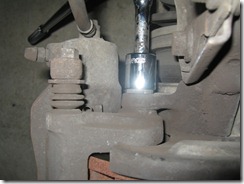
Then hang the brake caliper out-of-the-way with a hook or piece of wire, making sure not to put any strain on the brake line.
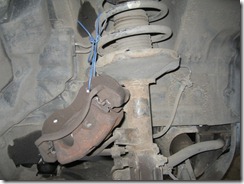
Then remove the 2 set screws as shown. Find a screwdriver that fits tight and use caution as these are easy to strip.
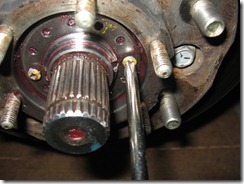
Then stick a pick or something sharp in one of the holes and jiggle the washer out. It’s a notched washer so you’ll have to pull it straight back.
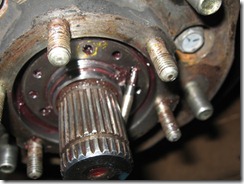
You should then see the main wheel bearing locknut. This circular nut has two large holes where you will insert the locknut socket.
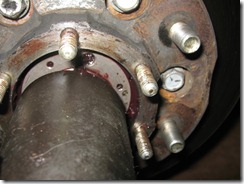
After removing the locknut socket, you should be able to just pull out the rotor. Be careful since the outer bearings will tend to fall out.

Finish off by removing the 6 large bolts on the hub. You can just lift off the hub and place it on your new disc rotor. Be sure to clean all the grease off the new rotor with brake cleaner or carb cleaner before putting it back on the car.
Just reverse these steps to put things back together.
When putting the wheel bearing locknut back on, be sure to spin it on with your fingers first to ensure that you don’t cross the threads. Then tighten with the special socket with the torque wrench to 58 ft-lb, turn the rotor several times in each direction, loosen the locknut then tighten to 4.3 – 13 in-lb, turn several times, then tighten again to 4.3 – 13 in-lb.
When replacing the brake caliper, you may need to spread the pads apart a little further with your pad spreader as the new rotor will be thicker than the worn one. If you are going to replace the pads with new ones, I would put the caliper back on first, then remove the bottom smaller bolt on the caliper and swing the cylinder body upward for easier access to the pads.
When putting back the snap rings, make sure they seat completely in the groove. To help with the outer snap-ring, grab the axle and pull while you push in the snap ring with the snap ring pliers. You should see it click into the groove.
Be sure to double check the tightness of all bolts before replacing the wheel.